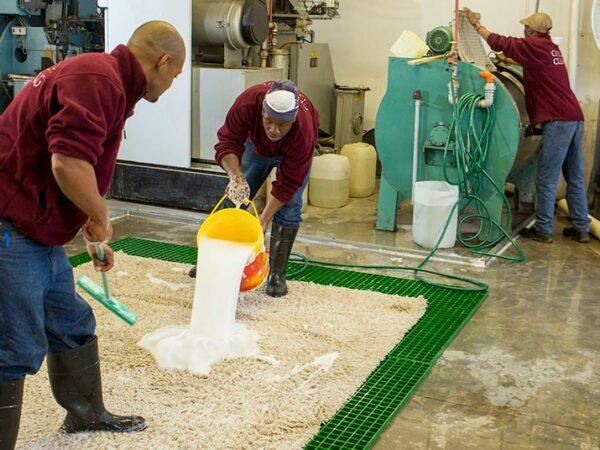
Water damage to carpets is a common and often costly issue – whether a geyser or pipe bursts, a ceiling leaks during the Cape winter or flood water makes it into a home.
We offer tips and advice on what to do next.
Act fast to minimise the damage
Water can be very damaging to carpets, the underfelt and the flooring beneath, especially if the substrate is wood.
Allowing water to sit will give it time to soak through and cause permanent damage that can be very costly to fix.
Immediately find the source of the water and take measures to stop it. In the case of a burst pipe or geyser, turn off the water to the whole house.
As soon as possible after a flood or burst pipe, take action to clean up the water and dry the carpets to minimise the extent of the water damage.
Must water-damaged carpet be replaced?
While this is often the case, not all water-damaged carpets must be replaced. It depends on how saturated the carpet got and how long it was wet for.
Carpets that get superficially wet because of a spill don’t usually require replacement and will dry on their own. You must soak up any excess water.
When carpets get fully saturated with standing water from a burst geyser or pipe, the underfelt and substrate will also get wet and it might not be possible to dry it.
In these circumstances, the carpet may develop mould and could start rotting because it cannot dry. The under flooring can also be structurally compromised.
Mould takes about 24 to 48 hours to start growing. If you miss this window, it’s more likely that your carpets won’t be recoverable.
Flood water can also contain hazardous contaminants. If a carpet is soaked by flood water from outside or water backing up from the sewerage system, it’s always advisable to replace it.
Steps for treating a water-damaged carpet
If you’re confident that the carpets can be saved, follow these steps.
Step 1: Remove any standing water
Remove as much standing water as possible from the area. Open doors and use a broom to sweep out standing water. You can also use a dustpan and a bucket.
Step 2: Soak up left-over water
Use towels and sponges to soak up the left-over water. Make sure you have a few buckets on hand to squeeze them into if there’s a lot of water.
Step 3: Use a wet dry vacuum
Use a wet dry vacuum cleaner to get rid of as much of the leftover dampness as possible. If you don’t own one, wet dry vacuums can be rented.
Step 4: Promote air circulation
Open all windows and set up some fans to get the air circulating. It might be necessary to do this for a few days to get the carpets completely dry.
Step 5: Professional cleaning
As a final step, professional carpet cleaning will remove any debris and sanitise the carpets, helping prevent mould.
However, it’s important to note that if water damage is significant, simple deep cleaning won’t reverse the damage.
Bonus step: Dry underneath the carpet
Depending on the type of carpet, it might be possible to lift the carpet, dry underneath and replace the underfelt. This is usually only worthwhile for expensive or brand-new carpeting.
Making an insurance claim for water damage to carpets
Household insurance often covers damage to fitted carpets in the event of sudden, unforeseen flooding.
How much it covers will depend on the type of policy you have and the cause of the damage. It might cover just the cleaning or having the carpets replaced completely.
Contact your insurer as soon as possible after any flooding. An inspector will come to assess the damage and the cause while it is still evident.
You may have to negotiate with your insurer based on the extent of the damage and how it was caused.
What we offer at Chelsea Cleaning
Unfortunately, we can’t reverse permanent water damage to carpets in Cape Town or help remove flood water.
However, we are experts at deep cleaning fitted carpets – and sometimes, this is enough to give even fairly badly stained carpeting a new lease on life. It can also remove mould spores and any musty odour.
Our method involves these steps:
- initial vacuuming
- use of specialised stain removers to spot-treat stains
- a hot water extraction method for cleaning and sanitising carpets
- a final vacuum.





